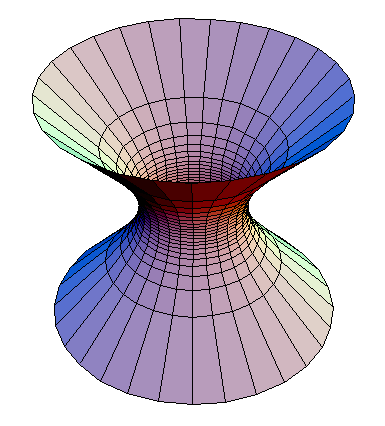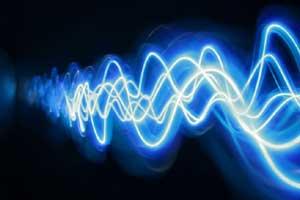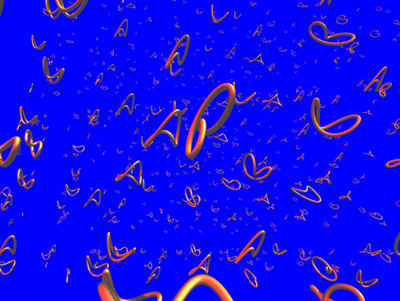 Read anything about string theory and you’ll soon learn that it resembles more of a religion than a scientific principle. String theory researchers and their supporters will be the first to tell you that this elegant, but extremely complex, integration of gravity and quantum field theory, cannot be confirmed through experiment. And, neither, can it be dispelled through experiment.
Read anything about string theory and you’ll soon learn that it resembles more of a religion than a scientific principle. String theory researchers and their supporters will be the first to tell you that this elegant, but extremely complex, integration of gravity and quantum field theory, cannot be confirmed through experiment. And, neither, can it be dispelled through experiment.
So, while the promise of string theory — to bring us one unified understanding of the entire universe — is deliciously tantalizing, it nonetheless forces us to take a giant leap of faith. I suppose that would put string theory originators, physicists Michael Green and John Schwarz, somewhere in the same pantheon as Moses and Joseph Smith.
From Quanta:
Thirty years have passed since a pair of physicists, working together on a stormy summer night in Aspen, Colo., realized that string theory might have what it takes to be the “theory of everything.”
“We must be getting pretty close,” Michael Green recalls telling John Schwarz as the thunder raged and they hammered away at a proof of the theory’s internal consistency, “because the gods are trying to prevent us from completing this calculation.”
Their mathematics that night suggested that all phenomena in nature, including the seemingly irreconcilable forces of gravity and quantum mechanics, could arise from the harmonics of tiny, vibrating loops of energy, or “strings.” The work touched off a string theory revolution and spawned a generation of specialists who believed they were banging down the door of the ultimate theory of nature. But today, there’s still no answer. Because the strings that are said to quiver at the core of elementary particles are too small to detect — probably ever — the theory cannot be experimentally confirmed. Nor can it be disproven: Almost any observed feature of the universe jibes with the strings’ endless repertoire of tunes.
The publication of Green and Schwarz’s paper “was 30 years ago this month,” the string theorist and popular-science author Brian Greene wrote in Smithsonian Magazine in January, “making the moment ripe for taking stock: Is string theory revealing reality’s deep laws? Or, as some detractors have claimed, is it a mathematical mirage that has sidetracked a generation of physicists?” Greene had no answer, expressing doubt that string theory will “confront data” in his lifetime.
Recently, however, some string theorists have started developing a new tactic that gives them hope of someday answering these questions. Lacking traditional tests, they are seeking validation of string theory by a different route. Using a strange mathematical dictionary that translates between laws of gravity and those of quantum mechanics, the researchers have identified properties called “consistency conditions” that they say any theory combining quantum mechanics and gravity must meet. And in certain highly simplified imaginary worlds, they claim to have found evidence that the only consistent theories of “quantum gravity” involve strings.
According to many researchers, the work provides weak but concrete support for the decades-old suspicion that string theory may be the only mathematically consistent theory of quantum gravity capable of reproducing gravity’s known form on the scale of galaxies, stars and planets, as captured by Albert Einstein’s theory of general relativity. And if string theory is the only possible approach, then its proponents say it must be true — with or without physical evidence. String theory, by this account, is “the only game in town.”
“Proving that a big class of stringlike models are the only things consistent with general relativity and quantum mechanics would be a way, to some extent, of confirming it,” said Tom Hartman, a theoretical physicist at Cornell University who has been following the recent work.
If they are successful, the researchers acknowledge that such a proof will be seen as controversial evidence that string theory is correct. “‘Correct’ is a loaded word,” said Mukund Rangamani, a professor at Durham University in the United Kingdom and the co-author of a paper posted recently to the physics preprint site arXiv.org that finds evidence of “string universality” in a class of imaginary universes.
So far, the theorists have shown that string theory is the only “game” meeting certain conditions in “towns” wildly different from our universe, but they are optimistic that their techniques will generalize to somewhat more realistic physical worlds. “We will continue to accumulate evidence for the ‘string universality’ conjecture in different settings and for different classes of theories,” said Alex Maloney, a professor of physics at McGill University in Montreal and co-author of another recent paper touting evidence for the conjecture, “and eventually a larger picture will become clear.”
Meanwhile, outside experts caution against jumping to conclusions based on the findings to date. “It’s clear that these papers are an interesting attempt,” said Matt Strassler, a visiting professor at Harvard University who has worked on string theory and particle physics. “But these aren’t really proofs; these are arguments. They are calculations, but there are weasel words in certain places.”
Proponents of string theory’s rival, an underdog approach called “loop quantum gravity,” believe that the work has little to teach us about the real world. “They should try to solve the problems of their theory, which are many,” said Carlo Rovelli, a loop quantum gravity researcher at the Center for Theoretical Physics in Marseille, France, “instead of trying to score points by preaching around that they are ‘the only game in town.’”
Mystery Theory
Over the past century, physicists have traced three of the four forces of nature — strong, weak and electromagnetic — to their origins in the form of elementary particles. Only gravity remains at large. Albert Einstein, in his theory of general relativity, cast gravity as smooth curves in space and time: An apple falls toward the Earth because the space-time fabric warps under the planet’s weight. This picture perfectly captures gravity on macroscopic scales.
But in small enough increments, space and time lose meaning, and the laws of quantum mechanics — in which particles have no definite properties like “location,” only probabilities — take over. Physicists use a mathematical framework called quantum field theory to describe the probabilistic interactions between particles. A quantum theory of gravity would describe gravity’s origin in particles called “gravitons” and reveal how their behavior scales up to produce the space-time curves of general relativity. But unifying the laws of nature in this way has proven immensely difficult.
String theory first arose in the 1960s as a possible explanation for why elementary particles called quarks never exist in isolation but instead bind together to form protons, neutrons and other composite “hadrons.” The theory held that quarks are unable to pull apart because they form the ends of strings rather than being free-floating points. But the argument had a flaw: While some hadrons do consist of pairs of quarks and anti-quarks and plausibly resemble strings, protons and neutrons contain three quarks apiece, invoking the ugly and uncertain picture of a string with three ends. Soon, a different theory of quarks emerged. But ideas die hard, and some researchers, including Green, then at the University of London, and Schwarz, at the California Institute of Technology, continued to develop string theory.
Problems quickly stacked up. For the strings’ vibrations to make physical sense, the theory calls for many more spatial dimensions than the length, width and depth of everyday experience, forcing string theorists to postulate that six extra dimensions must be knotted up at every point in the fabric of reality, like the pile of a carpet. And because each of the innumerable ways of knotting up the extra dimensions corresponds to a different macroscopic pattern, almost any discovery made about our universe can seem compatible with string theory, crippling its predictive power. Moreover, as things stood in 1984, all known versions of string theory included a nonsensical mathematical term known as an “anomaly.”
On the plus side, researchers realized that a certain vibration mode of the string fit the profile of a graviton, the coveted quantum purveyor of gravity. And on that stormy night in Aspen in 1984, Green and Schwarz discovered that the graviton contributed a term to the equations that, for a particular version of string theory, exactly canceled out the problematic anomaly. The finding raised the possibility that this version was the one, true, mathematically consistent theory of quantum gravity, and it helped usher in a surge of activity known as the “first superstring revolution.”
But only a year passed before another version of string theory was also certified anomaly-free. In all, five consistent string theories were discovered by the end of the decade. Some conceived of particles as closed strings, others described them as open strings with dangling ends, and still others generalized the concept of a string to higher-dimensional objects known as “D-branes,” which resemble quivering membranes in any number of dimensions. Five string theories seemed an embarrassment of riches.
Read the entire story here.
Image: Image of (1 + 1)-dimensional anti-de Sitter space embedded in flat (1 + 2)-dimensional space. The embedded surface contains closed timelike curves circling the x1 axis. Courtesy of Wikipedia.

 A small, but growing, idea in theoretical physics and cosmology is that spacetime may be emergent. That is, spacetime emerges from something much more fundamental, in much the same way that our perception of temperature emerges from the motion and characteristics of underlying particles.
A small, but growing, idea in theoretical physics and cosmology is that spacetime may be emergent. That is, spacetime emerges from something much more fundamental, in much the same way that our perception of temperature emerges from the motion and characteristics of underlying particles. Over the last 40 years or so physicists and cosmologists have sought to construct a single grand theory that describes our entire universe from the subatomic soup that makes up particles and describes all forces to the vast constructs of our galaxies, and all in between and beyond. Yet a major stumbling block has been how to bring together the quantum theories that have so successfully described, and predicted, the microscopic with our current understanding of gravity. String theory is one such attempt to develop a unified theory of everything, but it remains jumbled with many possible solutions and, currently, is beyond experimental verification.
Over the last 40 years or so physicists and cosmologists have sought to construct a single grand theory that describes our entire universe from the subatomic soup that makes up particles and describes all forces to the vast constructs of our galaxies, and all in between and beyond. Yet a major stumbling block has been how to bring together the quantum theories that have so successfully described, and predicted, the microscopic with our current understanding of gravity. String theory is one such attempt to develop a unified theory of everything, but it remains jumbled with many possible solutions and, currently, is beyond experimental verification.